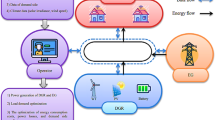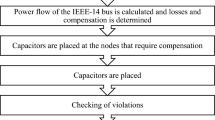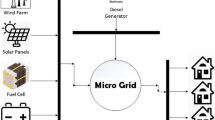Abstract
Encouraged by the increasing electric energy consumption, the distributed generation has been widely included in the electrical power system. However, renewable energy resources have intermittent characteristics. When the distributed generation is high at certain times of the day, the energy generation at distribution systems can become higher than the required power. The surplus energy is returned to the transmission system, giving rise to active distribution networks. This paper proposes an approach to optimally managing the existing distributed generation and voltage control devices. The management is performed by solving an optimal power flow problem, aiming to find an operating condition for the system in which the losses are minimized, and the voltage profiles are improved. A combined transmission and distribution system is proposed. Some scenarios are considered to assess the impact of distributed generation insertion and the contribution of these sources in support of reactive power. The results indicate the need for adequate active distribution networks management, which depends on the distribution generation insertion level and the generation sources’ power factor.





Similar content being viewed by others
Abbreviations
- \(\varOmega \)::
-
Set of circuits under analysis;
- \(\beta _i\)::
-
Set of generators connected to bus i;
- \(\nabla _i\)::
-
Set of loads connected to bus i;
- \(\varLambda _i\)::
-
Set of buses directly connected to bus i;
- \(\gamma _i\)::
-
Set of shunt elements connected to bus i;
- i, j::
-
System buses;
- G::
-
Generator number;
- T::
-
OLTC (on-load tap charger) number;
- L::
-
Load number;
- C::
-
Shunt element number;
- \(g_{ij}, b_{ij}\)::
-
Series conductance and susceptance between buses i and j;
- \(b_{ij}^{\,\mathrm sh}\)::
-
Shunt susceptance between buses i and j;
- \(a_{ij}\)::
-
Tap ratio of the transformer between buses i and j;
- \(\varphi _{ij}\)::
-
Phase shift of the transformer between buses i and j;
- \(V^{\, \mathrm{min}}_i, V^{\, \mathrm max}_i\)::
-
Minimum and maximum voltage limits of bus i;
- \(P^{\, \mathrm{min}}_G, P^{\, \mathrm max}_G\)::
-
Minimum and maximum active power limits of generator G;
- \(Q^{\, \mathrm{min}}_G, Q^{\, \mathrm max}_G\)::
-
Minimum and maximum reactive power limits of generator G;
- \(a^{\, \mathrm{min}}_T, a^{\, \mathrm max}_T\)::
-
Minimum and maximum tap ratio of OLTC T;
- \(P_L\)::
-
Active power demand of load L;
- \(Q_L\)::
-
Reactive power demand of load L;
- \(Q^{\, \mathrm sh}_C\)::
-
Reactive power injection from shunt elements C.
- \(P_\mathrm{loss}\)::
-
Total active system losses;
- \(P_{ij}\)::
-
Active power flow from bus i to j;
- \(P_{ji}\)::
-
Active power flow from bus j to i;
- \(Q_{ij}\)::
-
Reactive power flow from bus i to j;
- \(V_i\angle \theta _i\), \(V_j\angle \theta _j\)::
-
Magnitude and angle of the voltage at bus i and j, respectively;
- \(P_G\)::
-
Active power from generator G;
- \(Q_G\)::
-
Reactive power from generator G.
References
Chowdhury SP, Crossley P, Chowdhury S (2009) Microgrids and active distribution networks. Institution of Engineering and Technology (IET), Stevenage
Bollen M, Fainan H (2011) Integration of distributed generation in the power system. Wiley-IEEE Press, Pistacaway
Hatziargyriou N et al (2017) Techinical Report PES-TR22-contribution to bulk system control and stability by distributed energy resources connected at distribution network. IEEE Power & Energy Society, Pistacaway
EPRI-Electric Power Research Institute (2014) Impact of variable generation on voltage and frequency performance of the bulk system: case studies and lessons learned. EPRI, Palo Alto
Von Appen J et al (2013) Time in the sun: the challenge of high PV penetration in the German electric grid. IEEE Power Energy Mag 11(2):55–64. https://doi.org/10.1109/MPE.2012.2234407
WECC-Western Electricity Coordinating Council (2014) WECC solar power plant dynamic modeling guidelines. https://www.wecc.org/_layouts/15/WopiFrame.aspx?sourc edoc=/Reliability/WECC%20Solar%20Plant%20Dynamic%20Modeling%20Guidelines.pdf&action=default&Defau ltItemOpen=1 Accessed 12 july 2019
CEER-Council of European Energy Regulators (2017) CEER Report on power losses-Ref: C17-EQS-80-03. CEER, Brussels
Gumerman EZ et al (2003) Evaluation framework and tools for distributed energy resources. Technical Report - R&D Project: 767691. Lawrence Berkeley National Lab, Berkeley. https://www.osti.gov/biblio/816218. Accessed 26 Sept 2020
Ramos A, Belmans R (2016) DSO-TSO interactions in flexibility contracting. Presented at the CIGRE Session 46, Paris
Sotkiewicz P, Vignolo JM (2006) Nodal pricing for distribution networks: efficient pricing for efficiency enhancing DG. IEEE Trans Power Syst 21(2):1013–1014. https://doi.org/10.1109/TPWRS.2006.873006
Covino S, Levitt A, Sotkiewicz P (2016) Chapter 22-the fully integrated grid: wholesale and retail, transmission and distribution. Future of utilities-utilities of the future, pp 417–434. https://doi.org/10.1016/b978-0-12-804249-6.00022-1
Li Y et al (2018) Optimal distributed generation planning in active distribution networks considering integration of energy storage. Appl Energy 210:1073–1081. https://doi.org/10.1016/j.apenergy.2017.08.008
Aristidou P, Valverde G, Van Cutsem T (2015) Impact on transmission voltages of an advanced distribution voltage control: results of a case study. Presented at the IEEE PES General Meeting, Denver, pp 1–26. https://doi.org/10.13140/RG.2.1.1977.8320
Aristidou P, Valverde G, Van Cutsem T (2017) Contribution of distribution network control to voltage stability: a case study. IEEE Trans Smart Grid 8:106–116. https://doi.org/10.1109/TSG.2015.2474815
Wei D (2018) Two-tier static equivalent method of active distribution networks considering sensitivity, power loss and static load characteristics. Int J Electr Power Energy Syst 100:193–200. https://doi.org/10.1016/j.ijepes.2018.02.032
Sgouras KI et al (2017) Impact of reverse power flow on the optimal distributed generation placement problem. IET Gener Transmis Distrib 11:4626–4632. https://doi.org/10.1049/iet-gtd.2016.1791
Marujo D et al (2016) Uma proposta de operação dos sistemas de transmisso considerando redes de distribuição ativas via sistemas imunológicos artificiais. Presented at the IV Simpósio Brasileiro de Sistemas Elétricos de Potência, Natal, pp 1–9. https://doi.org/10.20906/CPS/SBSE2016-0111
Azzouz MA, Farag HE, El-Saadany EF (2017) Real-time fuzzy voltage regulation for distribution networks incorporating high penetration of renewable sources. IEEE Syst J 11:1702–1711. https://doi.org/10.1109/JSYST.2014.2330606
Bidgoli HS, Van Cutsem T (2018) Combined local and centralized voltage control in active distribution networks. IEEE Trans Power Syst 33:1374–1384. https://doi.org/10.1109/TPWRS.2017.2716407
Karagiannopoulos S, Aristidou P, Hug G (2018) A centralised control method for tackling unbalances in active distribution grids. In: Presented at the 2018 power systems computation conference (PSCC), Dublin, pp 1–7. https://doi.org/10.23919/PSCC.2018.8442493
Capitanescu F (2018) TSO-DSO interaction: active distribution network power chart for TSO ancillary services provision. Electric Power Systems Research 163 Part A, pp 226–230. https://doi.org/10.1049/iet-gtd.2016.1791
Tian Z et al (2016) Mixed-integer second-order cone programing model for VAR optimization and network reconfiguration in active distribution networks. IET Gener Transmis Distrib 10(8):1938–1946. https://doi.org/10.1049/iet-gtd.2015.1228
Yemane HS, Meeus L (2018) DSO-TSO cooperation issues and solutions for distribution grid congestion management. Energy Policy 120:610–621. https://doi.org/10.1016/j.enpol.2018.05.065
Silva J et al (2018) Estimating the active and reactive power flexibility area at the TSO-DSO interface. IEEE Trans Power Syst 33(5):4741–4750. https://doi.org/10.1109/TPWRS.2018.2805765
Marujo D et al (2019) Active distribution networks implications on transmission system stability. J Control Autom Electr Syst 30:380–390. https://doi.org/10.1007/s40313-019-00458-x
Pilatte N, Aristidou P, Hug G (2019) TDNetGen: an open-source, parametrizable, large-scale, transmission, and distribution test system. IEEE Syst J 13(1):729–737. https://doi.org/10.1109/JSYST.2017.2772914
Samaan N et al (2018) Combined transmission and distribution test system to study high penetration of distributed solar generation. In: Presented at the 2018 IEEE/PES transmission and distribution conference and exposition (T&D), Denver, pp 1–9. https://doi.org/10.1109/TDC.2018.8440238
Putra JT, Sarjiya IBSM (2015) Impact of high penetration of Photovoltaic Generation on voltage fluctuation of transmission and distribution systems. In: Presented at the 2015 2nd international conference on information technology, computer, and electrical engineering (ICITACEE), Semarang, pp 333–336. https://doi.org/10.1109/ICITACEE.2015.7437824
Balasubramaniam K, Abhyankar S (2017) A combined transmission and distribution system co-simulation framework for assessing the impact of Volt/VAR control on transmission system. In: Presented at the 2017 IEEE power & energy society general meeting, Chicago, pp 1–5. https://doi.org/10.1109/PESGM.2017.8274633
Cepel-Centro de Pesquisas de Energia Elétrica (2018) Programa Flupot-Manual do usuário versão 07.06.01. Cepel, Rio de Janeiro
Anderson PM, Fouad AA (2003) The elementary mathematical model. Power systems control and stability, 2nd edn. Wiley-IEEE Press, Pistacaway, pp 38–39
Bignucolo F, Caldon R, Prandoni V (2008) Radial MV networks voltage regulation with distribution management system coordinated controller. Electr Power Syst Res 78(4):634–645. https://doi.org/10.1016/j.epsr.2007.05.007
Bignucolo F (2009) Il controllo delle reti attive di distribuzione. Doctoral thesis, University of Padua
Reno MJ, Deboever J, Mather B (2017) Motivation and requirements for quasi-static time series (QSTS) for distribution system analysis. In: Presented at the IEEE power & energy society general meeting, Chicago, pp 1–5. https://doi.org/10.1109/PESGM.2017.8274703.
Agência Nacional de Energia Elétrica - ANEEL (2019) A ANEEL. https://www.aneel.gov.br/a-aneel. Accessed 12 July 2019
ONS - Operador Nacional do Sistema Elétrico (2018) Procedimentos de Rede. In: Submódulo 23.3 – Diretrizes e critérios para estudos elétricos. http://www.ons.org.br/paginas/sobre-o-ons/procedimentos-de-rede/vigentes. Accessed 12 July 2019
ANEEL - Agência Nacional de Energia Elétrica (2018) Procedimentos de Distribuição de Energia Elétrica no Sistema Elétrico Nacional PRODIST. In: Módulo 8 - Qualidade da energia elétrica. https://www.aneel.gov.br/modulo-8. Accessed 12 July 2019
Hooshmand RA, Mohkami H (2011) New optimal placement of capacitors and dispersed generators using bacterial foraging oriented by particle swarm optimization algorithm in distribution systems. Electr Eng 93:43–53. https://doi.org/10.1007/s00202-010-0191-1
Fadel W, Kilic U, Taskin S (2017) Placement of DG, CB, and TCSC in radial distribution system for power loss minimization using back-tracking search algorithm. Electr Eng 99:791–802. https://doi.org/10.1007/s00202-016-0448-4
Ali ES, Abd Elazim SM, Abdelaziz AY (2018) Optimal allocation and sizing of renewable distributed generation using ant lion optimization algorithm. Electr Eng 100:99–109. https://doi.org/10.1007/s00202-016-0477-z
Givisiez AG, Petrou K, Ochoa LF (2020) A review on TSO-DSO coordination models and solution techniques. Electric Power Syst Res. https://doi.org/10.1016/j.epsr.2020.106659
Gonzalez DM, Myrzik J, Rehtanz C (2020) The smart power cell concept: mastering TSO-DSO interactions for the secure and efficient operation of future power systems. IET Gener Transmission Distrib 14(13):2407–2418. https://doi.org/10.1049/iet-gtd.2019.0991
Zegers A, Brunner H (2014) TSO-DSO interaction: an Overview of current interaction between transmission and distribution system operators and an assessment of their cooperation in Smart Grids. International Smart Grid Action Network (ISAGN) Discussion Paper Annex 6 Power T&D Systems - Task 5. https://www.iea-isgan.org/wp-content/uploads/2014/02/ISGAN_DiscussionPaper_TSOD SOInteractionOverview_2014.pdf. Accessed 26 September 2020
Author information
Authors and Affiliations
Corresponding author
Additional information
Publisher's Note
Springer Nature remains neutral with regard to jurisdictional claims in published maps and institutional affiliations.
Rights and permissions
About this article
Cite this article
Marujo, D., Zanatta, G.L. & Floréz, H.A.R. Optimal management of electrical power systems for losses reduction in the presence of active distribution networks. Electr Eng 103, 1725–1736 (2021). https://doi.org/10.1007/s00202-020-01182-5
Received:
Accepted:
Published:
Issue Date:
DOI: https://doi.org/10.1007/s00202-020-01182-5




